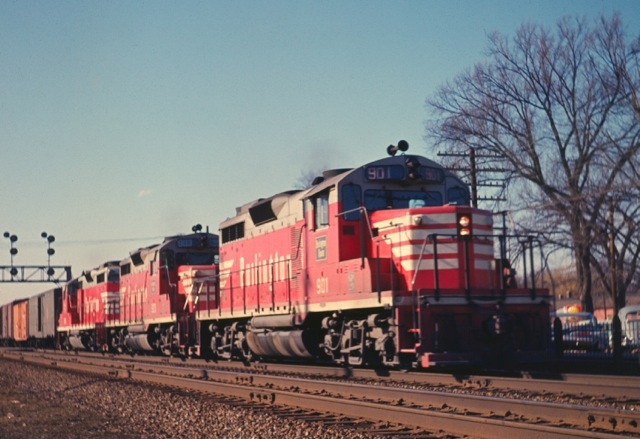Here are four GP20 photos, one of the 917 in the original sill paint scheme in 1964, the other three all wearing the full width white paint scheme, which was applied to units only during 1969 and early 1970. Those shown are 902, 905 and 919, which, with the 925 Tom mentions, makes at least four units that got this variation. It should be noted that this was done concurrently with the full width white sill scheme on the SD7s and SD9s.
Hol
To: CBQ@yahoogroups.com From: clipperw@gmail.com Date: Thu, 8 Mar 2012 08:10:49 -0600 Subject: [CBQ] Re: Wide White Sill Stripes on CB&Q GP20's
Tom,
I checked several of my photos of Q GP20s in the Q era and they are all painted with the handrail stanchions black on the white stripe. Attached is a photo of what appears to be three of them in Downers grove in in January, 1964.
When EMD painted locomotives, the handrails and grab irons were all in place. The order of paint application was designed so that the minimum of masking would be necessary. On the Q chinese red units, the black underbody would likely have been paint first although trucks and fuel tanks usually were painted before application and then lightly repainted on the completed locomotive. The gray would most likely have been the first carbody color, followed by the white and then the red. Handrails, grab irons and other accessories that were called out in a different color, would have been painted by hand, usually with a brush.
Sorry that my photo isn't of the 905 or the 925. The photo shows 901, 903 and a third unit that looks like another GP20.
Bill Barber
Gravois Mills, MO

Wed Mar 7, 2012 6:19 pm (PST)
I was looking through Diesel Era's "GP20 and SD24" book and found photos of two GP20's with the wide sill stipes. The units are both BN sub-lettered but still in Chinese Red. They are:
BN 2041, nee CB&Q 905
BN 2061, nee CB&Q 925
Interestingly the white stripe paint was applied over the handrail stanchions where they bolt to the side frame. It appears that on the original paint scheme the handrails were either applied after the white sill stripe was painted or the handrail stanchions were masked because the portion of the stanchions on the original paint that overlap the white stripe are in black (the entire stancion was black). Also, the stanchions just in front of the cab and behind the cab that attach to the red body are painted red where the attache to the body, and the same goes for the handrail itself.
To put it another way, on the original Chinese Red scheme it would appear that the locomotive was painted, then the stanchions and handrails were painted painted black, and then attached to the locomotive.
On the later wide sill stripe scheme, it would appear the handrails were painted black while on the unit, then they were masked just to wherever they overlapped/bolted onto the frame or carbody, then the red or white pain was applied to the locomotive which included painting the handrail or stanchions where they bolted to the body. Hence certain portions of the handrails and stanchions are either red or white.
Also of note is that in the original screen the hand grab across the front of the endplate which a creman riding the running boards would grab hold of and the coupler cut levers are black to match the rest of the handrails. On the later wide sill strip version the hand grab and coupler cut levers are painted red.
Does anyone have shots of 905 or 925 that show them pre-merger in the wide sill stripe scheme?
P.S. to Bryan Howell (if you monitor this group): The BRHS website "CB&Q to BN Diesel" list should be updated to show 905 and 925 as having the CR&G* paint scheme at merger time.
Tom Mack
Cincinnati, OH
__._,_.___
![]()
__,_._,___
|
 CB&Q 917, Lincoln, Neb., 10-1964, Hol Wagner photo.jpg
CB&Q 917, Lincoln, Neb., 10-1964, Hol Wagner photo.jpg
Description: JPEG image
 CB&Q 902, wide stripe, Denver, Colo., 10-1970, Hol Wagner photo.jpg
CB&Q 902, wide stripe, Denver, Colo., 10-1970, Hol Wagner photo.jpg
Description: JPEG image
 CB&Q 905, wide stripe, Denver, Colo., 11-1970, Hol Wagner photo.jpg
CB&Q 905, wide stripe, Denver, Colo., 11-1970, Hol Wagner photo.jpg
Description: JPEG image
 CB&Q 919, wide stripe, Denver, Colo., 2-1970, Hol Wagner photo.jpg
CB&Q 919, wide stripe, Denver, Colo., 2-1970, Hol Wagner photo.jpg
Description: JPEG image
|